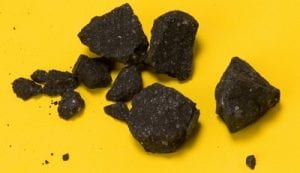UCF Physicist Contributes to Recent Meteorite Research
 It’s a big month for space exploration. Among the headlines: the successful landing of a spacecraft on a comet, the stunning findings unearthed in meteorites recovered from California, and the rollout of NASA’s next-generation Orion crew capsule expected to take its test flight in December.
It’s a big month for space exploration. Among the headlines: the successful landing of a spacecraft on a comet, the stunning findings unearthed in meteorites recovered from California, and the rollout of NASA’s next-generation Orion crew capsule expected to take its test flight in December.
“It’s an exciting time to be involved in space exploration,” said Mehmet Yesiltas, a University of Central Florida physics doctoral student who recently co-authored one of 13 papers dedicated to findings made from the Sutter’s Mill meteorite.
The journal Meteoritics & Planetary Science dedicated this month’s issue to the Sutter’s Mill discoveries because the findings were so unusual. The materials found within the rocks include chemicals that were heated and cooled. Usually chemicals found in meteorites are one or the other, but not both.
“The mix suggests complex events in space that asteroids and comets undergo and it also suggests that primitive asteroids and comets may hold chemical clues to understanding how our solar system first formed,” Yesiltas said.
That’s one reason why the European Space Agency’s Rosetta mission that landed on a comet Nov. 13 and upcoming NASA and Japan Space Agency missions OSIRIS-REx and Hayabusa 2 to collect and bring back asteroid samples are also generating excitement.
“Like my dissertation work, the Rosetta mission gives an opportunity to peek into formation and evolution of life’s building blocks, and therefore formation of life,” he said. “Asteroids and comets may have bombarded early Earth, delivering their chemical composition to Earth via meteorites. Primitive asteroids like the targets of OSIRIS-REx and Hayabusa 2 may have even more clues.”
But deciphering these clues is no easy task. From recovering enough samples to using sophisticated techniques with advanced equipment, the process takes time and effort and often the findings generate more questions than answers.
Yesiltas spent months studying the Sutter’s Mill samples at the Synchrotron Radiation Center at University of Wisconsin-Madison and at the Material Characterization Facility at UCF to get the best analysis and infrared images possible.
Yesiltas’ research area of focus is meteorites, but he eagerly awaits the results of the Rosetta mission and looks forward to the discoveries to be made through OSIRIS-REx, Hayabusa 2 and even manned flights of the future.
Yesiltas’s collaborators on the Sutter’s Mill paper include: Yoko Kebukawa from the Yokohama National University in Japan, Robert Peale from UCF, Eric Mattison and Carol J. Hirschmugl from the University of Wisconsin-Milwaukee, and Peter Jenniskens from the SETI Institute and NASA Ames Research Center. Jenniskens is the lead investigator for the Sutter’s Mill Meteorite Consortium and also a lead author or collaborator on all the papers in the journal.
Yesiltas has a master’s degree in physics from Florida State University and a bachelor’s degree from Ondokuz Mayis University in Turkey. He joined UCF in 2011 to seek a Ph.D. and as a research assistant. He spent his summer of 2012 at NASA’s Ames Research Center working on the infrared spectroscopy of meteorites He expects to earn his Ph.D. in physics from UCF in 2015.
Read original story from UCF Today here.
